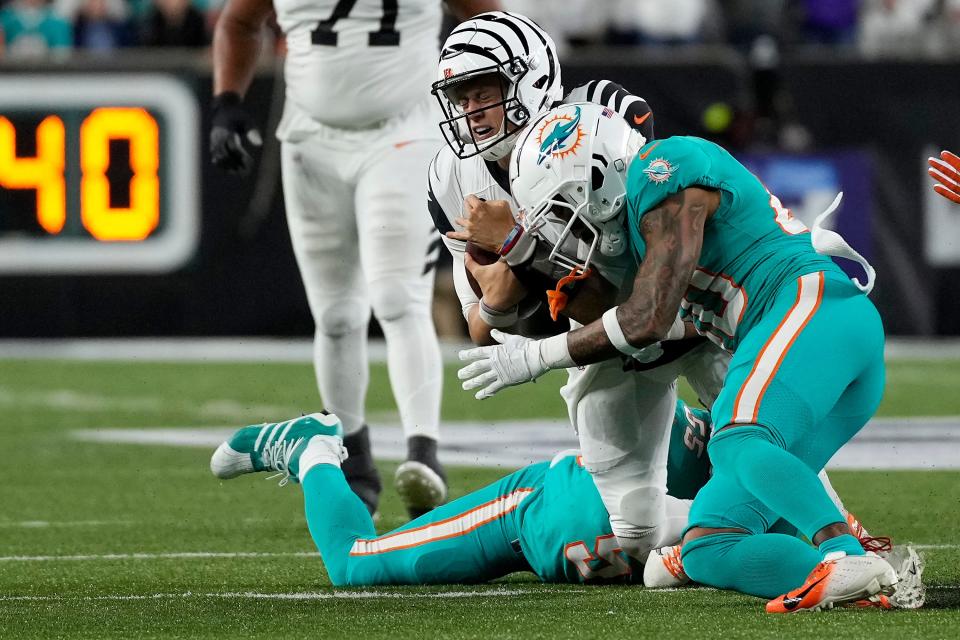NFL culture getting another wake-up call on concussions following Joe Burrow's comments | Opinion
- Oops!Something went wrong.Please try again later.
Joe Burrow has played in games that he doesn’t even remember.
And the Cincinnati Bengals star, mindful of the risks and impact of concussions sustained while playing a brutal sport, chalks it up as an occupational hazard.
“I mean, it’s scary,” Burrow said during an interview on the “Colin Cowherd Podcast” that was published on Wednesday. “Everybody knows the profession that we do. It’s a dangerous game and that’s always a possibility. And when it happens, you collectively hold your breath.”
Go ahead, shudder.
As the NFL and NFL Players Association finish up their review of the concussion suffered last Thursday by Miami Dolphins quarterback Tua Tagovailoa – and the protocols and procedures attached to that setback and another injury suffered four days earlier – one of football’s brightest stars addressed the issue in maybe the same vein as you’d consider a sprained ankle.
NFL NEWSLETTER: Sign up now for exclusive content sent to your inbox
ONE QUESTION: Could have protected Tua Tagovailoa from serious injury

Please, even if Burrow struck you as being a bit cavalier, don’t shoot the messenger.
Burrow, 25, was giving us some more straight talk that speaks to football’s culture – not just the NFL, but colleges, high schools and other levels of the sport – and the mentality that many carry in pursuing their athletic endeavors.
Sure, it has to make the NFL nervous to have one of its marquee talents open up about his concussion experiences – the raw honesty being one of the reasons Burrow has such an appealing presence. He’s not sure exactly how many concussions he’s suffered but feels fortunate that he hasn’t had any injuries that caused him to miss extensive time or left him with a headache for weeks.
Then again, as more has been learned about the long-term effects of concussions and the link to chronic traumatic encephalopathy (CTE) caused by repeated blows to the head, Burrow – and many others like him – could be doing themselves a disservice by minimizing the apparent concussions that did not register as severe.
It’s the cumulative effect of concussions that have stacked up over time that can be so scary.
“I’ve had some when I don’t remember the second half or I don’t remember the entire game or I know I got a little dizzy at one point,” Burrow said. “But nothing long-lasting.”
Hopefully.
The type of experience that Burrow described is similar to those expressed by so many others over the years with increasing attention on the effects of concussions. A generation ago, high-profile quarterbacks Steve Young and Troy Aikman were real-life examples of the risks as they produced Hall of Fame careers. Before that, star receiver Al Toon and quarterback Roger Staubach illuminated the risks.
Now, with the league and players union expected this week to tweak concussion protocols and announce findings of the investigation into Tagovailoa’s case (the quarterback was interviewed on Tuesday), the concussion issue is front-and-center again.
This case may be another hit on the NFL’s precious image, but it’s also, no pun intended, a “wake-up call” that should remind the league, and especially the people entrusted with the power to make a difference – to remove players, star players from games if need to – that it can’t get comfortable (or sloppy) when it comes to concussions.
The NFL has been proactive in recent years with health and safety initiatives driven by a mission to take the head out of the game, including dozens of playing rules changes. The protocols and manpower in place to address head injuries mark a stark difference from the way it used to be.
Until Tagovailoa’s case, there had not been a concussion controversy of this magnitude in the NFL for several years, which the league undoubtedly took as an indication that its efforts have been working.
Still, Hall of Fame coach Tony Dungy derided the system as “broken” during a series of tweets this week inspired by the handling of Tampa Bay Buccaneers tight end Cameron Brate, who returned to the game against the Kansas City Chiefs on Sunday night after apparently suffering a concussion.
Dungy, like others watching the game, believed it was obvious that Brate suffered a suspected head injury during a collision late in the second quarter – and should have been examined for that.
The Bucs, though, contended that Brate didn’t exhibit concussion symptoms until halftime. The tight end originally reported a shoulder injury, then returned to the game for the remainder of the half.
Just as striking was the conclusion reached by the NFL and NFLPA – which jointly operate on the concussion front – in maintaining that Brate was hit in the shoulder rather than the head.
Yeah, right. That explains the concussion. And it explains why, as it looks to modify the system, the league and union need to heed the wake-up call.
This article originally appeared on USA TODAY: Joe Burrow's concussion comments sound alarm for NFL culture yet again

